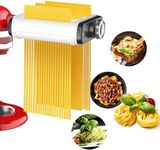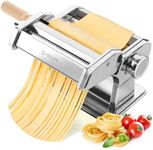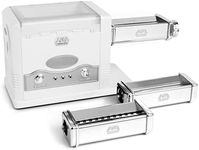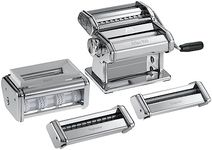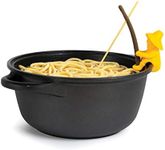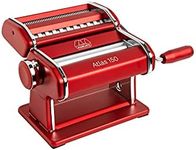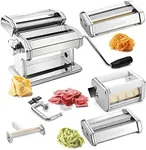Buying Guide for the Best Pasta Machines
Choosing a pasta machine can be a fun and rewarding process, especially if you love making fresh pasta at home. The right pasta machine will make the process easier, more consistent, and enjoyable. When shopping for a pasta machine, it's important to consider how often you plan to use it, what types of pasta you want to make, and how much effort you're willing to put into the process. Understanding the key features will help you find a machine that fits your needs and makes pasta-making a breeze.Type (Manual vs. Electric)The type of pasta machine refers to whether it is operated by hand (manual) or powered by electricity (electric). Manual machines require you to turn a crank to roll and cut the dough, giving you more control and a traditional experience, but they require more effort. Electric machines automate the rolling and cutting, making the process faster and easier, especially if you plan to make pasta frequently or in larger quantities. If you enjoy hands-on cooking and don't mind a bit of work, a manual machine might be best. If you want convenience and speed, especially for regular use, consider an electric model.
Material and Build QualityMaterial and build quality refer to what the machine is made of and how sturdy it feels. Most pasta machines are made from stainless steel, which is durable, easy to clean, and resistant to rust. Some may have plastic parts, which can be lighter but less durable. A well-built machine will last longer and perform better, especially with frequent use. If you plan to use your pasta machine often, look for one with mostly metal parts and a solid, stable feel.
Adjustable Thickness SettingsAdjustable thickness settings allow you to control how thick or thin your pasta sheets are. This is important because different types of pasta require different thicknesses. Machines usually have a dial or knob with several settings, ranging from very thin to thick. If you want to make a variety of pasta types, look for a machine with a wide range of thickness options. If you only plan to make one or two types, fewer settings may be sufficient.
Pasta Shape AttachmentsPasta shape attachments are additional parts that let you make different types of pasta, such as spaghetti, fettuccine, or ravioli. Some machines come with a few basic cutters, while others offer a range of optional attachments. If you want to experiment with many pasta shapes, choose a machine that supports multiple attachments. If you prefer to stick to classic shapes, a basic set may be all you need.
Ease of CleaningEase of cleaning refers to how simple it is to keep the machine clean after use. Pasta machines can get dough stuck in the rollers and cutters, so it's important to choose one that can be easily wiped down or taken apart for cleaning. Some machines are designed to be cleaned with a brush or cloth, while others have removable parts. If you want to save time and effort, look for a machine with straightforward cleaning instructions and accessible parts.
Stability and MountingStability and mounting refer to how securely the machine stays in place during use. Manual machines often come with a clamp to attach them to your countertop, preventing movement while you crank the handle. A stable machine makes rolling dough easier and safer. If you have limited counter space or plan to use the machine on different surfaces, check that the mounting system is strong and adaptable.





